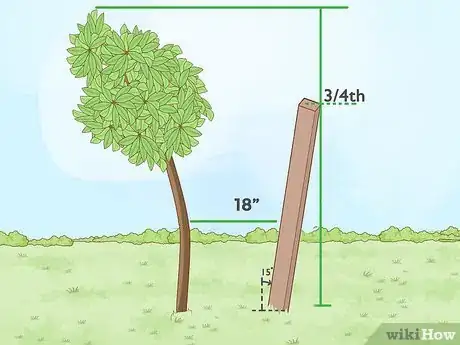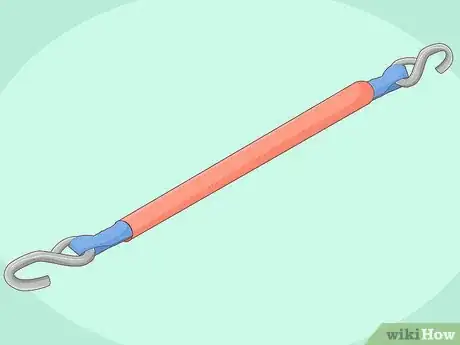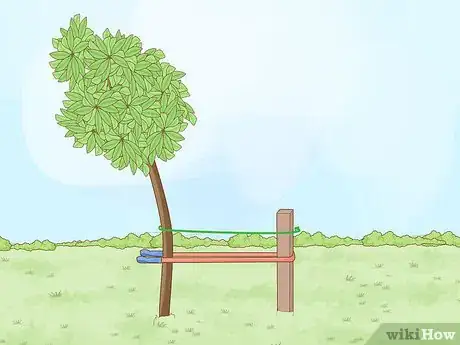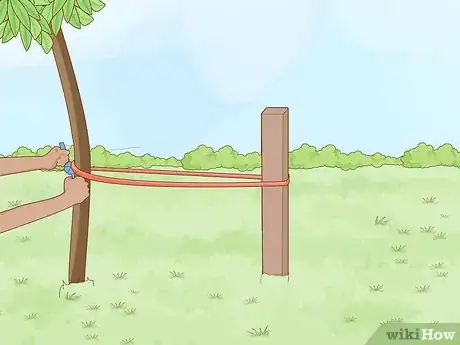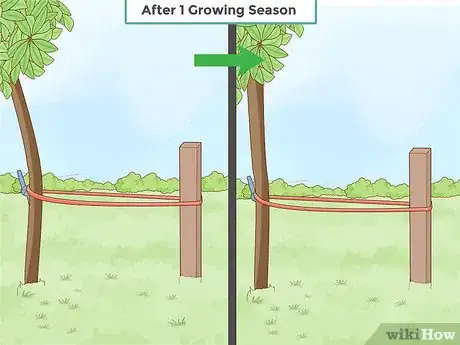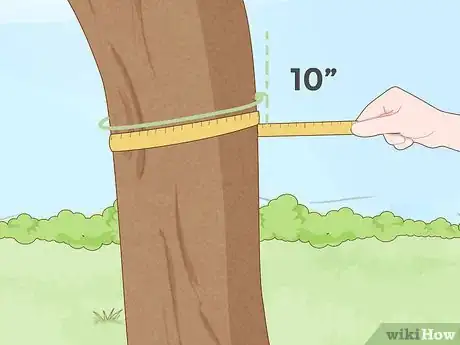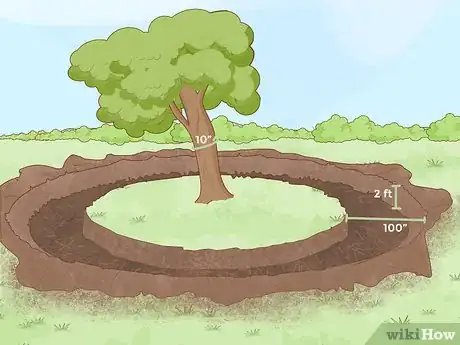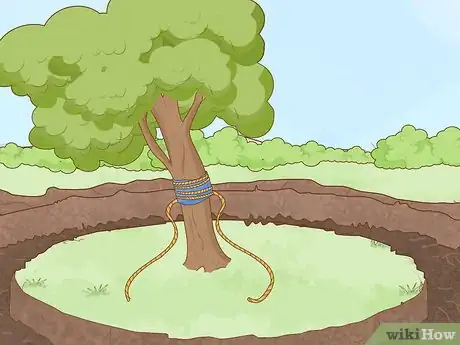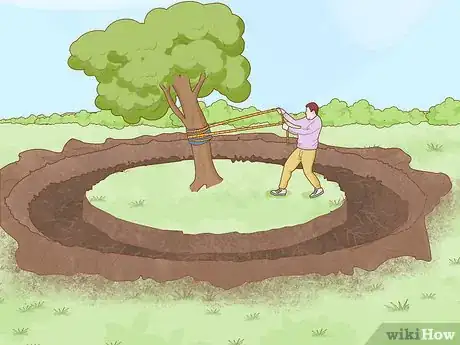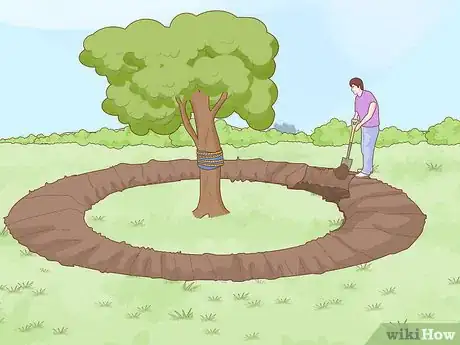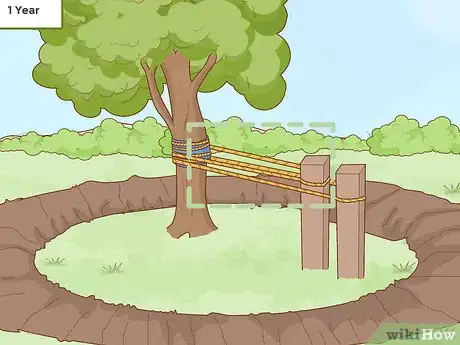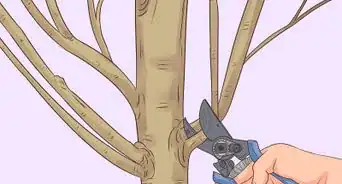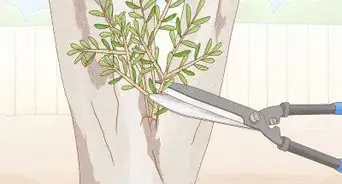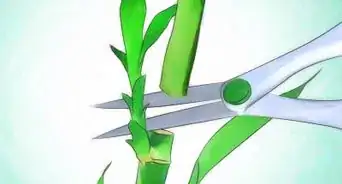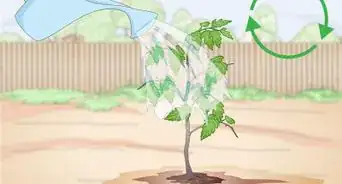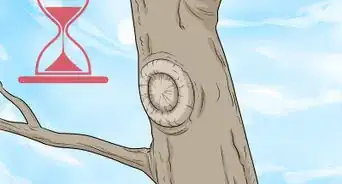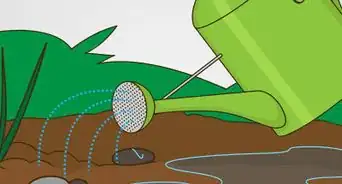This article was co-authored by Lauren Kurtz. Lauren Kurtz is a Naturalist and Horticultural Specialist. Lauren has worked for Aurora, Colorado managing the Water-Wise Garden at Aurora Municipal Center for the Water Conservation Department. She earned a BA in Environmental and Sustainability Studies from Western Michigan University in 2014.
This article has been viewed 175,433 times.
Trees usually grow straight up just fine on their own, but sometimes you’ll have that one tree in your yard that’s growing crooked because of high winds or storm damage. Luckily, you can straighten out a crooked tree on your own. How difficult it’s going to be depends on whether you’re dealing with a small or large tree, but either way we’ve got you covered! This article will walk you through exactly what to do step-by-step.
Steps
Staking a Small Leaning Tree
-
1Pound a stake into the ground in the opposite direction than the tree is leaning. Hammer the stake about 18 in (46 cm) away from the tree and 18 in (46 cm) into the ground at about a 15-degree angle away from the tree. [1]
- You can use a pickaxe to get the hole started, or wet the ground with a hose first to soften it and make it easier to pound the stake in.
- Avoid damaging the roots when placing the stake.
- You can buy stakes made of treated wood at a garden store or home improvement center.
- The stake should be about 3/4 of the height of the tree, and can be about 2–4 in (5.1–10.2 cm) in diameter.
- This method will work for trees that are of a size you can straighten by pulling on it with your hands. If you cannot move the tree with your hands, then you will need to use another method to straighten it.
-
2Feed a ratchet strap through a piece of rubber hose. Use an old piece of garden hose or get a piece of rubber hose at a hardware store. Feed the ratchet strap through it until it is in the middle of the strap.[2]
- Make sure the piece of hose is long enough to wrap about 3/4 of the way around the trunk of the tree to protect the bark.
- You can use wire fed through a piece of rubber hose as well, but a strap with a ratchet is easier to tighten.
- Straps with ratchets are available at home improvement stores, or you can find special tree straightening straps at a garden store.
- Don't use wire or tight rope as a tree strap as these will damage the bark and potentially kill the tree.
Advertisement -
3Wrap the hose around the back of the tree and pull the strap to the stake. Wrap the strap around the side of the tree that is leaning towards one direction. Place it about 18 in (46 cm) high above the ground. Pull the loose ends of the strap towards the stake.[3]
- If the tree is particularly small and flimsy, then place the strap closer to the ground wherever it seems more stable. Pull on the tree with the strap gently to make sure the tree can still stand on its own under pressure.
-
4Tie the strap around the stake and ratchet it tight. Tie the loose ends in a tight knot around the stake. Ratchet the strap until the tree is standing straight.[4]
- Don’t tighten the strap so that the tree cannot move at all. You want it to be able to move a bit in the wind so the roots grow strong.
-
5Monitor the tree and tighten the strap when it becomes loose. Check on the tree at least once a week and take slack out of the strap. This will keep the tree from leaning again and help it to grow straight.[5]
- You should also check on the tree after any big wind storms to make sure it is still held securely in place.
-
6Remove the straps and stakes after 1 growing season. Loosen the straps a bit at first to make sure that the tree is standing straight. Take the straps off completely when you see that the tree can stand straight on its own.[6]
- A growing season is the period of the year during which trees and other plants grow the most. Usually, a growing season is about 90 days long but can last for a whole year in tropical climates.
- You can start the staking process at any time of the year, but make sure to let the tree pass through a full growing season before you remove the strap.
Correcting a Large Leaning Tree
-
1Measure the circumference of the tree with a flexible tape measure. Wrap the tape measure around the thickest part of the tree trunk. You will use this measurement to calculate how big of a trench you need to dig around the root system.[7]
- If you don’t have a flexible tape measure, you could use a piece of string and a regular tape measure. Wrap the string around the trunk, then measure how much string fits around the trunk with a regular tape measure.
- This method of straightening will work for trees that are too big to straighten by pulling on with a strap and stake system.
-
2Dig a trench around the base of the tree to free the roots. Use a shovel to dig a circular trench around the trunk of the tree that is at least 10 in (25 cm) wide for every 1 in (2.5 cm) of the trunk’s diameter. Make the hole about 2 ft (0.61 m) deep.[8]
- For example, if the tree’s diameter is 20 in (51 cm), then you would need to dig a trench that is at least 200 in (510 cm) wide.
- If the tree is particularly large and you don’t want to dig it out yourself, you can hire a tree moving company to dig the hole with a tree spade.
- Really large trees will not correct easily. Consider leaving your tree leaning to avoid damaging the roots and killing your mature tree.
-
3Place a pad on the trunk and wrap a rope around the pad. Put the pad on the side of the tree that is leaning. Wrap the rope around the mat and tie it in a loop to secure it in place.[9]
- You can use a foam pad like a camping mat, or some old blankets, as a pad to protect the tree’s bark.
-
4Pull the tree with the rope to straighten it. Get a lot of helpers to pull the tree straight, or attach the rope to a truck and slowly accelerate to start straightening the tree. Stop pulling if the tree is not moving and dig out the trench more to loosen the root system. Stop pulling and leave the rope attached to the tree and truck when the tree is standing straight.[10]
- Don’t pull up the roots without loosening them first, or you risk tearing them and killing the tree.
-
5Fill in the hole around the tree with the dirt you dug out. Use a shovel to pack the dirt back into the trench and cover the roots. Put as much of the dirt back in as you can to give the roots a good foundation. Remove the rope from the tree and truck after you fill in the hole.[11]
- It can take at least a year for the roots to re-establish themselves once you have loosened them and shifted the tree.
-
6Wrap tree straightening straps around the tree for at least 1 year. Pound 2-3 wooden stake posts at least 18 in (46 cm) into the ground further away from the tree than the trench you dug, so that they don't hit the root system. Wrap tree straightening straps around the middle of the trunk and secure them to the posts to hold the tree in place.
- You can get special tree straps at home improvement centers.
- The straps will keep the tree stable so that the roots can re-establish themselves.
- Not all trees can be successfully straightened. Sometimes the roots have trouble re-establishing themselves. In this case, you may not be able to save the tree from dying.
- Before you remove the straps, try loosening them a bit to make sure the tree stands firmly on its own.
Community Q&A
-
QuestionFor measuring, do I use the diameter or circumference?For correcting a large, leaning tree, you need to measure the circumference, not the diameter.
-
QuestionMy tree is a cherry blossom. It was planted at least 10 or more years ago. Can it still be straightened?Yes, it can but it will take a long time. If a tree was planted more than 7-8 years ago, there is a possibility that it will straighten, but over quite a long period of time. You can wrap tree straightening straps around the tree and over time it may straighten. Sometimes it won't fully straighten, though.
-
QuestionWe have 2 birch trees, not weeping, but 'straight'. They are now about 10 feet in height. Some upper branches are leaning quite a bit. Not sure why as we do not have ice or heavy snow storms here.
 Addison SmithCommunity AnswerYou can trim those branches off if they are causing a huge issue or you can use string to pull the tree back into its spot.
Addison SmithCommunity AnswerYou can trim those branches off if they are causing a huge issue or you can use string to pull the tree back into its spot.
Things You’ll Need
Staking a Small Leaning Tree
- Stake
- Ratchet strap
- Sledgehammer or mallet
- Rubber hose
Correcting a Large Leaning Tree
- Shovel
- Pad
- Ropes
- Tree straps
References
- ↑ https://www.bobvila.com/articles/how-to-stake-a-tree/
- ↑ https://www.bobvila.com/articles/how-to-stake-a-tree/
- ↑ https://www.bobvila.com/articles/how-to-stake-a-tree/
- ↑ https://www.bobvila.com/articles/how-to-stake-a-tree/
- ↑ https://www.bobvila.com/articles/how-to-stake-a-tree/
- ↑ https://www.bobvila.com/articles/how-to-stake-a-tree/
- ↑ https://www.thisoldhouse.com/ask-toh/straightening-leaning-tree
- ↑ https://www.thisoldhouse.com/ask-toh/straightening-leaning-tree
- ↑ https://www.thisoldhouse.com/ask-toh/straightening-leaning-tree
About This Article
The easiest way to straighten a small tree is to support it with a stake. First, pound your stake into the ground at an angle so it’s pointing in the opposite direction to the leaning tree. Then, feed a ratchet strap through a piece of rubber hose, which you'll find at a hardware store. Once your ratchet strap is in place, wrap the hose around the tree and pull the strap around the stake. Next, tie the strap around the stake and ratchet it tight until the tree is standing straight. After a week or 2, begin loosening the strap gradually to see if the tree can stand straight by itself. You can remove the strap completely after 1 growing season. If your leaning tree is larger, you'll need to dig a trench around it, then get lots of helpers to straighten it up by pulling on a rope tied around it. For tips on how to pull a larger tree with a truck, keep reading!
